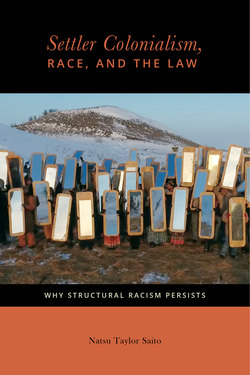Читать книгу Settler Colonialism, Race, and the Law - Natsu Taylor Saito - Страница 22
На сайте Литреса книга снята с продажи.
Indigenous Worlds
ОглавлениеThe master narrative cannot accurately recognize the myriad Indigenous cultures that long predated the colonization of this continent, because doing so would disrupt its story of linear progress, discredit its “civilizing mission,” and expose the crude motivations underlying the racialization of American Indians and, subsequently, other peoples of color. To justify the United States’ very existence, as well as the wealth and power it has derived by appropriating Indigenous lands and resources, the settler narrative contends, implicitly or explicitly, that this was, or might as well have been, uninhabited land.69 As we question the prevailing paradigm and consider more liberatory options, it is particularly important to address this “silent space.” This is not because returning to a precolonial past is an option but because there is much it can teach us about human relations, forms of social and political organization, and ways of relating to other societies and the natural world outside the colonial paradigm. These insights, in turn, undermine the narrative’s disempowering message that what we see, here and now, is the best of all possible worlds.
We can start by noting that as of the fifteenth century, “most likely, over 100 million inhabitants who spoke at least 1000 languages inhabited the Americas”70 and, prior to the European invasion, some fifteen million people probably lived in what is now the continental United States and Canada.71 Indigenous narratives are rooted in epistemologies very different from those of the colonial powers, and generally begin with origin stories. None support the settlers’ assertion that American Indians walked from Siberia to North America some fifteen thousand years ago, a story that conveniently sets the stage for settler claims that Indigenous peoples are really just immigrants, too. Thus, for example, Hopi history incorporates the destruction of their lands by volcanic fire, flooding, and ice, events that geologists correlate to floods as well as glacial and volcanic activity that took place twenty-five thousand or more years ago.72 In other accounts, the People emerged from worlds beneath this one, or came from the sky when the earth was still covered with water.73 Many peoples trace their origins to specific geographic sites, such as the Lakotas’ understanding of their emergence from Wind Cave in the Black Hills;74 others tell of traveling great distances, “listen[ing] to the Earth” in order to find where they were supposed to be.75
Whatever their particularities, Indigenous “origin stories connect the People to the land.”76 Their cultures, histories, and identities are usually rooted in a given location—defined, perhaps, by particular mountains or rivers—and they are correspondingly responsible for ensuring the well-being of these nonhuman relatives. As Cree attorney Sharon Venne notes, “Every indigenous ‘legal code’ devolves upon . . . requirements that humans shoulder an individual/collective responsibility to preserve the balance of the natural order.”77
This approach allowed the Indigenous peoples of the Americas to develop complex cosmologies and cultures, sophisticated systems of agricultural production, and extensive networks of trade and communication that survived for millennia.78 American Indian scholars John Mohawk and Oren Lyons provide this much-condensed but very revealing summary:
Long before Columbus made contact . . . some Native American civilizations had developed vast irrigation networks that rivaled those of Rome; they had domesticated crops that would eventually save Europe from starvation; they had developed medical and psychotherapeutic knowledge that made medieval Europe’s medical model . . . look primitive; they had advanced astronomical calendars; they had a body of literature, both oral and in some cases written, that is only today finally being recognized as the equal of any found in the world; and they had developed highly sophisticated forms of representative government in which freedom was not only prized, but was the foremost principle.79
The Haudenosaunee (Rotinonshón:ni) or Iroquois League, composed of the Mohawk, Onondaga, Seneca, Cayuga, Oneida, and Tuscarora nations, is one example of these sophisticated forms of governance.80 The Haudenosaunee Great Law of Peace provides for a complex, consensus-based system of checks and balances among the constituent nations of the League, including the election of leaders, delineation of their responsibilities, and provisions for their removal.81 The Articles of Confederation and the US Constitution were strongly influenced by the Great Law of Peace, illustrating the settlers’ consciousness of Indigenous political and legal structures.82 Structured to govern relations between independent nations, it constitutes a body of international law, and in the early years of European settlement, the colonies of New York, Pennsylvania, Maryland, and Virginia agreed to join the Haudenosaunee Covenant Chain, a “relationship of trade and collective security” built upon treaties.83
As the utilization of Haudenosaunee political insights by the Angloamerican “founders” illustrates, the colonizers were quite well aware that the Indigenous peoples they were encountering had highly sophisticated forms of social organization, extensive agricultural production, and well-developed trade routes. As early as 1614, John Smith was recruiting settlers for the Plymouth Colony by describing the land as “planted with Gardens and Corne fields” and “well inhabited with a goodly, strong and well proportioned people.”84 The settlers themselves wrote countless accounts of their attacks on Indigenous peoples’ towns, villages, and crops.85 Even as Removal was underway, the Cherokee nation had a national council, a written constitution and laws, a supreme court, schools, libraries, newspapers, large towns, farms with tens of thousands of head of cattle, and dozens of mills and blacksmith shops.86 The settlers’ portrayals of American Indians as “uncivilized” were simply counterfactual, and the colonial leaders knew it.
